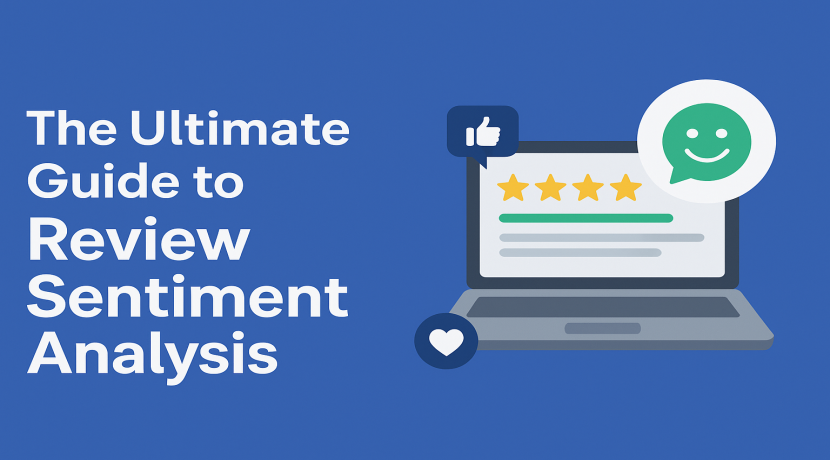
The Ultimate Guide to Review Sentiment Analysis
2025-Sep-23
In today's hyper-connected world, every customer review, social media comment, and online forum discussion holds immense power. For businesses, this ocean of unstructured text is a goldmine of insights—if you have the right tools to navigate it. Manually sifting through thousands of reviews is not just inefficient; it’s impossible. This is where review sentiment analysis comes in. By using AI and natural language processing (NLP), sentiment analysis tools automatically categorize and interpret the emotional tone behind customer feedback, transforming raw data into actionable intelligence that can fuel your business growth. From improving products and services to crafting more effective marketing campaigns, understanding what your customers feel is the new competitive advantage.
What is Review Sentiment Analysis and Why is it Essential?
At its core, sentiment analysis, or "opinion mining," is the process of using automated tools to determine the emotional tone of a piece of text—positive, negative, or neutral. It goes beyond a simple star rating. A 3-star review might be "neutral," but sentiment analysis can reveal the nuance. For example, a customer might write: "The delivery was incredibly fast and the packaging was excellent, but the product itself feels cheap." A simple star rating misses this. Sentiment analysis, however, can pinpoint the positive sentiment on "delivery" and "packaging" and the negative sentiment on "product quality."
This level of detailed insight is essential for several reasons:
-Actionable Insights at Scale: You can analyze thousands of reviews instantly, identifying widespread issues or popular features that would take a human team weeks to find.
-Proactive Issue Resolution: Catching a trend of negative feedback about a specific product feature or customer service agent allows you to address the problem before it escalates into a full-blown reputation crisis.
-Enhanced Product Development: By understanding the specific pain points and delights of your customers, you can prioritize product improvements based on real-world feedback, not just guesswork. A study by the Harvard Business Review found that companies that effectively use customer feedback for product innovation can see a 10-15% increase in customer satisfaction.
Top 2025 Review Management Platforms
As the importance of sentiment analysis has grown, so has the technology. The market for review management platforms is more competitive than ever, with new players and features constantly emerging. Here is a curated list of top-tier platforms in 2025, each with a unique value proposition.
RatingIcon.com: A dedicated review intelligence platform designed for growing businesses and franchises.
Key Features: Monitors reviews from over 100+ sites, providing real-time alerts and competitor analysis. The platform's advanced sentiment analysis identifies key phrases and themes in reviews, allowing you to create custom reports and track performance against competitors.
Pricing: Starts at $0/month for 1 month, with custom plans for larger organizations.
-Integrations: Integrates with Zapier, Hootsuite, and Tableau for a seamless workflow.
-Best For: Businesses with a strong focus on data-driven insights and multi-location management.
Provide Free review sentiment analysis report that aligning Sentiment Analysis with Your Business Goals
Simply having a powerful tool isn't enough; you must know how to use it to achieve your strategic objectives. Here's how to align your sentiment analysis platform with different business goals:
Goal: Enhance Customer Service
-Action: Use real-time alerts to immediately flag negative sentiment reviews. Create a workflow where customer support agents are notified and can respond personally and promptly. This proactive approach can turn a dissatisfied customer into a loyal advocate.
-Example: A hospitality chain uses a tool like Review Trackers to monitor guest feedback. When a review mentions "long check-in lines" with negative sentiment, the system automatically alerts the hotel manager. They can then respond to the guest, offer a small gesture, and immediately address the staffing issue for the future.
Getting Started: The Path to Growth
Implementing a robust review management and sentiment analysis strategy is no longer a luxury—it's a necessity for any business looking to thrive. It’s about more than just collecting stars; it's about listening to the story behind the rating, understanding the emotions that drive customer behavior, and using those insights to make smarter, more profitable decisions.
Are you ready to transform your customer feedback into a powerful engine for business growth? Take the first step today. Explore how a dedicated platform can simplify the process and unlock the true potential of your reviews. Start your journey toward data-driven growth and a stronger online reputation.
Ready to see how RatingIcon can transform your review strategy? Sign up for a free trial today to see real-world sentiment analysis in action and start your journey to better customer insights and business growth.
FAQs (Frequently Asked Questions)
Q. How can get free review sentiment analysis report ?
With RatingIcon you can easily access free tool. click the link.
Q. Can sentiment analysis work for any industry?
Yes, sentiment analysis is highly versatile. It is used across various industries, including retail, hospitality, healthcare, finance, and technology. The key is to choose a platform that is trained on industry-specific language and has customizable features to fit your unique needs.
Q. What's the difference between sentiment analysis and a simple keyword search?
A keyword search simply tells you if a word is present. For example, a search for "slow" would find reviews with that word. Sentiment analysis, on the other hand, understands the context. It can differentiate between "The service was slow" (negative sentiment) and "This slow-motion video feature is amazing" (positive sentiment). This contextual understanding is what makes sentiment analysis so valuable.